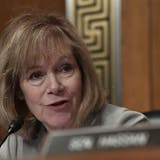Minnesota's western neighbors frequently paste tourism ads of mountain goats or badlands across TV and smartphone screens, buses and billboards. For years, they've barely drawn more than a harrumph from state political leaders.
Not so today.
"Drives me mad when I see commercials from South Dakota," Gov. Tim Walz says. He wants to coax Minnesotans into talking more about life in Minnesota and has an advertising blitz of his own in mind.
"I'm going to run ads in Florida for teachers," Walz said in a recent conversation with the Star Tribune about the state's economy and policy choices.
"'Come here! Yeah, it's a little colder," he said, nodding at the window on a day of single-digit temperatures. "But we'll let you teach."
That shot at the Sunshine State's prohibition against teachers from discussing sexual orientation or gender identity appears emblematic of his desire to infuse quality-of-life arguments with a progressive edge.
"If you're going to move to Minnesota, you're going to get a high-quality education," Walz said. "If you're going to move to Minnesota, you're going to have access to the arts."
Nearly three years after the start of the pandemic, Minnesota's employers need people. The state's 3 million person workforce is about 3% smaller than it was at the start of the pandemic.


